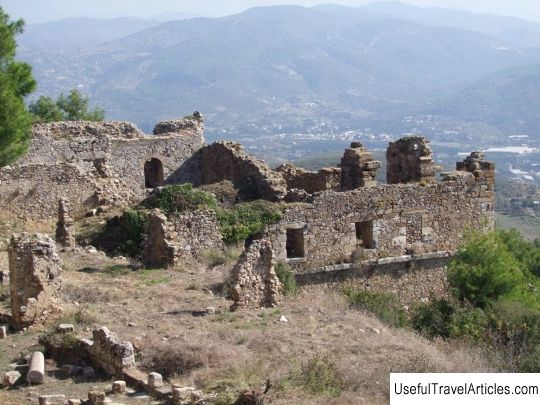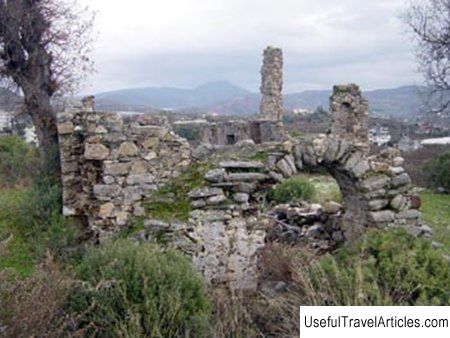Syedra Ruins description and photos - Turkey: Alanya
Rating: 8,5/10 (4506 votes) 
Syedra Ruins description and photos - Turkey: Alanya. Detailed information about the attraction. Description, photographs and a map showing the nearest significant objects. The title in English is Syedra Ruins. Photo and descriptionSyedra is an ancient city in Cilicia on the southern coast of Asia Minor. On the shores of a small bay near Alanya, about 35 km away, are the ruins of this ancient city. You can get there only by car. It is located on a hill that serves as the dividing line between the current villages of Korgisak and Seki. When you approach the city, you will have a panoramic view of the Mediterranean in full splendor. The nearest settlement is the village of Seki. It has retained a special touch of antiquity, thanks to the fact that local residents used a large amount of building materials from the antique period when building their homes. Excavations in this area continued for quite a long time and until recently did not bring any special results. The biggest surprise awaited archaeologists at the foot of the hill, where the remains of a settlement were found, most likely dating back to the period from the 7th to the 13th century AD. The ruins of Syedra are the ruins of a Roman city founded in the 3rd century. BC. Numerous mosaics and columns, a triumphal arch and three antique pools-reservoirs, which apparently served as reservoirs of drinking water used by local residents to irrigate fields, are perfectly preserved to this day. The water in the reservoirs is replenished thanks to a nearby source, which was discovered in ancient times. Distinctive features in the design of the walls of the source allow us to attribute it to the ancient Roman period. The interior of the reservoirs was covered with plaster. Its reddish marks can still be seen today. The alternate filling of reservoirs was ensured by a special stepped water supply system, during the survey of which only one outlet was found. Also, colored wall paintings were discovered in a cave that is located next to the source. They can be viewed only thanks to lighting devices. Little information about the history of Syedra has survived to this day. For the first time, the city is mentioned in written sources dating back to the middle of the 1st century BC. It is known that in 48 BC. here stayed Pompey, returning from the war. It is also reliably known that in the era of the Roman Empire from Tiberius (18 - 37 AD) to Gallen (260 - 268 AD) in the city of Syedra, its own currency was minted. Also in the city were found coins minted in honor of Marcus Aurelius and Anthony in the period from 138 to 161. Not far from the road and on the adjoining hill, you can see the remains of the lower city, parts of its walls, a necropolis and a bathhouse. A little higher, in the northeast, from high steep cliffs, a beautiful view of the city acropolis and Sedir Chaiyi opens up. There is one more interesting structure that has survived on the territory of this city, it is a two-storey building, inside of which remained parts of the mosaic. Some historians are of the opinion that this is a basilica, while others are sure that in the past it was a palace. The first statement is supported by well-preserved buildings located on both sides of the building's ledges. To the north of this building there is a street of the ancient city. In its various places you can find fragments of granite columns, testifying to the high level of prosperity and the former greatness of the city in the Byzantine era. In the center of the settlement there is a very large cave. Apparently, it was carved into the rock before our era. The cave, judging by the frescoes located at the entrance, was a place for religious rituals, and even later was used as a refuge. You can climb into it even now, but you won't be able to wander there, since all the passages are littered with stones. The remains of a Turkish bath located in the eastern part of the city are also of particular interest. They are quite impressive in size. In some places, fragments of the floor covered with patterned mosaics are still visible. This is most likely an ornament made in the traditional Turkish style, often found in bath complexes of ancient times. Near the baths, from north to south, there is a wide road with columns along the sides. On the northern side of this road, there are walls with recesses in the form of niches. There are still disagreements between researchers and scientists about the purpose of this building and the time of its erection. Specialists of the Alanya Archaeological Museum conducted a study in 1994, the results of which shocked everyone. It turns out that the pillared road previously had a width of ten meters, and its length was approximately two hundred and fifty meters. The columns on the southern side of the road had a roof, while those on the north side were covered with wood. Between them there was a platform paved with stone. Archaeologists at this place have found a lot of tablets with written records of competitions or games, conducted during that period. Some of them were sent to the archaeological museums of the world for study. Perhaps these tablets are related to this place, but it is still too early to assert this with an accuracy of 100%. In the evenings, the ruins of the ancient city are illuminated, thanks to which vacationers create the illusion of unreality, a synthesis of antiquity and modernity.       We also recommend reading Irkutsk Regional Art Museum. V. P. Sukacheva description and photo - Russia - Siberia: Irkutsk Topic: Syedra Ruins description and photos - Turkey: Alanya. |




